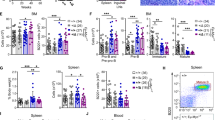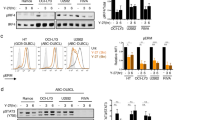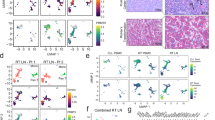Abstract
Sporadic Burkitt lymphoma (sBL) is a rapidly growing B-cell non-Hodgkin’s lymphoma whose treatment requires highly aggressive therapies that often result severely toxic. Identification of proteins whose expression or function is deregulated in sBL and play a role in its formation could facilitate development of less toxic therapies. We have previously shown that E2F1 expression is deregulated in sBL. We have now investigated the mechanisms underlying E2F1 deregulation and found that the E2F sites in its promoter fail to repress its transcriptional activity in BL cells and that the transcriptional repressor E2F4 barely interacts with these sites. We also have found that E2F4 protein levels, but not those of its mRNA, are reduced in sBL cell lines relative to immortal B-cell lines. E2F4 protein expression is also decreased in 24 of 26 sBL tumor samples from patients compared with control tissues. Our data demonstrate that enforced E2F4 expression in BL cells not only diminishes E2F1 levels, but also reduces selectively the tumorigenic properties and proliferation of BL cells, while increasing their accumulation in G2/M. Our results therefore point to E2F4 as a target for developing novel and less toxic treatments for sBL.
This is a preview of subscription content, access via your institution
Access options
Subscribe to this journal
Receive 12 print issues and online access
$259.00 per year
only $21.58 per issue
Buy this article
- Purchase on Springer Link
- Instant access to full article PDF
Prices may be subject to local taxes which are calculated during checkout







Similar content being viewed by others
References
Jaffe ES, Harris NL, Stein H, Vardiman JW . Pathology and Genetics of Tumours of Haematopoietic and Lymphoid Tissues. IARC Press: Lyon, France, 2008.
Kearns DB, Smith RJ, Pitcock JK . Burkitt’s lymphoma. Int J Pediatr Otorhinolaryngol 1986; 12: 73–84.
Yustein JT, Dang CV . Biology and treatment of Burkitt’s lymphoma. Curr Opin Hematol 2007; 14: 375–381.
Patte C, Auperin A, Gerrard M, Michon J, Pinkerton R, Sposto R et al. Results of the randomized international FAB/LMB96 trial for intermediate risk B-cell non-Hodgkin lymphoma in children and adolescents: it is possible to reduce treatment for the early responding patients. Blood 2007; 109: 2773–2780.
Klein G . Burkitt lymphoma—a stalking horse for cancer research? Semin Cancer Biol 2009; 19: 347–350.
Bellan C, De Falco G, Lazzi S, Leoncini L . Pathologic aspects of AIDS malignancies. Oncogene 2003; 22: 6639–6645.
Hotchin NA, Allday MJ, Crawford DH . Deregulated c-myc expression in Epstein-Barr-virus-immortalized B-cells induces altered growth properties and surface phenotype but not tumorigenicity. Int J Cancer 1990; 45: 566–571.
Packham G, Cleveland JL . c-Myc and apoptosis. Biochim Biophys Acta 1995; 1242: 11–28.
Felsher DW, Zetterberg A, Zhu J, Tlsty T, Bishop JM . Overexpression of MYC causes p53-dependent G2 arrest of normal fibroblasts. Proc Natl Acad Sci USA 2000; 97: 10544–10548.
Molina-Privado I, Rodriguez-Martinez M, Rebollo P, Martin-Perez D, Artiga MJ, Menarguez J et al. E2F1 expression is deregulated and plays an oncogenic role in sporadic Burkitt's lymphoma. Cancer Res 2009; 69: 4052–4058.
DeGregori J . The genetics of the E2F family of transcription factors: shared functions and unique roles. Biochim Biophys Acta 2002; 1602: 131–150.
Johnson DG, Schneider-Broussard R . Role of E2F in cell cycle control and cancer. Front Biosci 1998; 3: 447–458.
Chen HZ, Tsai SY, Leone G . Emerging roles of E2Fs in cancer: an exit from cell cycle control. Nat Rev Cancer 2009; 9: 785–797.
Cobrinik D . Pocket proteins and cell cycle control. Oncogene 2005; 24: 2796–2809.
Flemington EK, Speck SH, Kaelin WG . E2F-1 mediated transactivation is inhibited by complex formation with the retinoblastoma susceptibility gene product. Proc Natl Acad Sci USA 1993; 90: 6914–6918.
Blais A, Dynlacht BD . E2F-associated chromatin modifiers and cell cycle control. Curr Opin Cell Biol 2007; 19: 658–662.
Moberg K, Starz MA, Lees JA . E2F-4 switches from p130 to p107 and pRB in response to cell cycle reentry. Mol Cell Biol 1996; 16: 1436–1449.
Knudsen ES, Wang JY . Dual mechanisms for the inhibition of E2F binding to RB by cyclin-dependent kinase-mediated RB phosphorylation. Mol Cell Biol 1997; 17: 5771–5783.
Xiao ZX, Ginsberg D, Ewen M, Livingston DM . Regulation of the retinoblastoma protein-related protein p107 by G1 cyclin-associated kinases. Proc Natl Acad Sci USA 1996; 93: 4633–4637.
Takahashi Y, Rayman JB, Dynlacht BD . Analysis of promoter binding by the E2F and pRB families in vivo: distinct E2F proteins mediate activation and repression. Genes Dev 2000; 14: 804–816.
Verona R, Moberg K, Estes S, Starz M, Vernon JP, Lees JA . E2F activity is regulated by cell cycle-dependent changes in subcellular localization. Mol Cell Biol 1997; 17: 7268–7282..
Jaffe ES, Harris NL, Stein H, Vardiman JW . Pathology and Genetics of Tumours of Haematopoietic and Lymphoid Tissues. IARC Press: Lyon, France, 2001.
Campanero MR, Flemington EK . Regulation of E2F through ubiquitin-proteasome-dependent degradation: stabilization by the pRB tumor suppressor protein. Proc Natl Acad Sci USA 1997; 94: 2221–2226.
Neuman E, Flemington EK, Sellers WR, Kaelin WG . Transcription of the E2F-1 gene is rendered cell cycle dependent by E2F DNA-binding sites within its promoter. Mol Cell Biol 1994; 14: 6607–6615.
Campanero MR, Herrero A, Calvo V . The histone deacetylase inhibitor trichostatin A induces GADD45 gamma expression via Oct and NF-Y binding sites. Oncogene 2008; 27: 1263–1272.
Campanero MR, Armstrong M, Flemington E . Distinct cellular factors regulate the c-myb promoter through its E2F element. Mol Cell Biol 1999; 19: 8442–8450.
Santis AG, Campanero MR, Alonso JL, Sanchez-Madrid F . Regulation of tumor necrosis factor (TNF)-alpha synthesis and TNF receptors expression in T lymphocytes through the CD2 activation pathway. Eur J Immunol 1992; 22: 3155–3160.
Alvaro-Blanco J, Martinez-Gac L, Calonge E, Rodriguez-Martinez M, Molina-Privado I, Redondo JM et al. A novel factor distinct from E2F mediates C-MYC promoter activation through its E2F element during exit from quiescence. Carcinogenesis 2009; 30: 440–448.
Shirodkar S, Ewen M, DeCaprio JA, Morgan J, Livingston DM, Chittenden T . The transcription factor E2F interacts with the retinoblastoma product and a p107-cyclin A complex in a cell cycle regulated manner. Cell 1992; 68: 157–166.
Araki K, Nakajima Y, Eto K, Ikeda MA . Distinct recruitment of E2F family members to specific E2F-binding sites mediates activation and repression of the E2F1 promoter. Oncogene 2003; 22: 7632–7641.
Iwase S, Furukawa Y, Kikuchi J, Nagai M, Terui Y, Nakamura M et al. Modulation of E2F activity is linked to interferon-induced growth suppression of hematopoietic cells. J Biol Chem 1997; 272: 12406–12414.
Nilsson K, Giovanella BC, Stehlin JS, Klein G . Tumorigenicity of human hematopoietic cell lines in athymic nude mice. Int J Cancer 1977; 19: 337–344.
Rempel RE, Mori S, Gasparetto M, Glozak MA, Andrechek ER, Adler SB et al. A role for E2F activities in determining the fate of Myc-induced lymphomagenesis. PLoS Genet 2009; 5: e1000640.
Adams JM, Harris AW, Pinkert CA, Corcoran LM, Alexander WS, Cory S et al. The c-myc oncogene driven by immunoglobulin enhancers induces lymphoid malignancy in transgenic mice. Nature 1985; 318: 533–538.
Kovalchuk AL, Qi CF, Torrey TA, Taddesse-Heath L, Feigenbaum L, Park SS et al. Burkitt lymphoma in the mouse. J Exp Med 2000; 192: 1183–1190.
Nevins JR . The Rb/E2F pathway and cancer. Hum Mol Genet 2001; 10: 699–703.
Christensen J, Cloos P, Toftegaard U, Klinkenberg D, Bracken AP, Trinh E et al. Characterization of E2F8, a novel E2F-like cell-cycle regulated repressor of E2F-activated transcription. Nucleic Acids Res 2005; 33: 5458–5470.
Onda M, Nagai H, Yoshida A, Miyamoto S, Asaka S, Akaishi J et al. Up-regulation of transcriptional factor E2F1 in papillary and anaplastic thyroid cancers. J Hum Genet 2004; 49: 312–318.
Goto Y, Hayashi R, Muramatsu T, Ogawa H, Eguchi I, Oshida Y et al. JPO1/CDCA7, a novel transcription factor E2F1-induced protein, possesses intrinsic transcriptional regulator activity. Biochim Biophys Acta 2006; 1759: 60–68.
Xu G, Livingston DM, Krek W . Multiple members of the E2F transcription factor family are the products of oncogenes. Proc Natl Acad Sci USA 1995; 92: 1357–1361.
Trimarchi JM, Lees JA . Sibling rivalry in the E2F family. Nat Rev Mol Cell Biol 2002; 3: 11–20.
Furukawa Y, Iwase S, Kikuchi J, Nakamura M, Yamada H, Matsuda M . Transcriptional repression of the E2F-1 gene by interferon-alpha is mediated through induction of E2F-4/pRB and E2F-4/p130 complexes. Oncogene 1999; 18: 2003–2014.
Piccaluga PP, De Falco G, Kustagi M, Gazzola A, Agostinelli C, Tripodo C et al. Gene expression analysis uncovers similarity and differences among Burkitt lymphoma subtypes. Blood 2011; 117: 3596–3608.
Hateboer G, Kerkhoven RM, Shvarts A, Bernards R, Beijersbergen RL . Degradation of E2F by the ubiquitin-proteasome pathway: regulation by retinoblastoma family proteins and adenovirus transforming proteins. Genes Dev 1996; 10: 2960–2970.
Hofmann F, Martelli F, Livingston DM, Wang Z . The retinoblastoma gene product protects E2F-1 from degradation by the ubiquitin-proteasome pathway. Genes Dev 1996; 10: 2949–2959.
Marti A, Wirbelauer C, Scheffner M, Krek W . Interaction between ubiquitin-protein ligase SCFSKP2 and E2F-1 underlies the regulation of E2F-1 degradation. Nat Cell Biol 1999; 1: 14–19.
Kinross KM, Clark AJ, Iazzolino RM, Humbert PO . E2f4 regulates fetal erythropoiesis through the promotion of cellular proliferation. Blood 2006; 108: 886–895.
van Amerongen MJ, Diehl F, Novoyatleva T, Patra C, Engel FB . E2F4 is required for cardiomyocyte proliferation. Cardiovasc Res 2010; 86: 92–102.
Garneau H, Paquin MC, Carrier JC, Rivard N . E2F4 expression is required for cell cycle progression of normal intestinal crypt cells and colorectal cancer cells. J Cell Physiol 2009; 221: 350–358.
Campanero MR . Mechanisms involved in Burkitt's tumor formation. Clin Transl Oncol 2008; 10: 250–255.
Acknowledgements
We thank D Trono (Ecole Polytechnique Federale de Lausanne, Lausanne, Swisse) for psPAX2 and pMD2G-VSVG plasmids and JM Redondo and JM Zapata for critical reading of the manuscript. We are indebted to JM Redondo and MJ Artiga for their continuous support and to the CNIO Tumor Bank for kindly providing the cases included in this study. MRC was supported by the Spanish Council for Scientific Research (CSIC) and the Spanish Ministry of Science and Innovation (SAF2010-15126). MAP and SM-M were supported by the Spanish Ministry of Science and Innovation (RETICC, SAF2008-03871) and the Spanish Association against Cancer (AECC).
Author information
Authors and Affiliations
Corresponding author
Ethics declarations
Competing interests
The authors declare no conflict of interest.
Additional information
Supplementary Information accompanies the paper on the Leukemia website
Supplementary information
Rights and permissions
About this article
Cite this article
Molina-Privado, I., Jiménez-P, R., Montes-Moreno, S. et al. E2F4 plays a key role in Burkitt lymphoma tumorigenesis. Leukemia 26, 2277–2285 (2012). https://doi.org/10.1038/leu.2012.99
Received:
Revised:
Accepted:
Published:
Issue Date:
DOI: https://doi.org/10.1038/leu.2012.99
Keywords
This article is cited by
-
DNA methylation profiles in chronic lymphocytic leukemia patients treated with chemoimmunotherapy
Clinical Epigenetics (2019)
-
Epigenomic evolution in diffuse large B-cell lymphomas
Nature Communications (2015)



